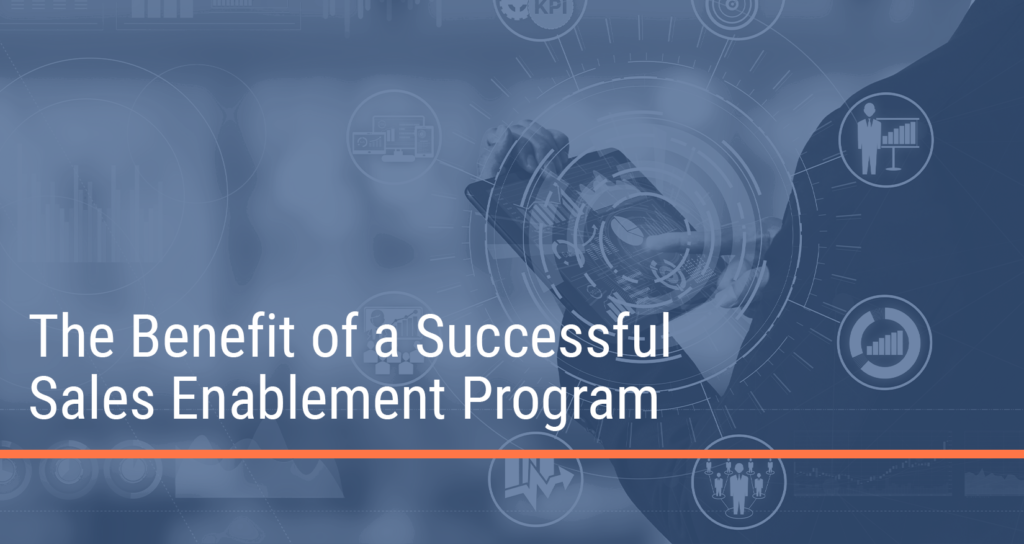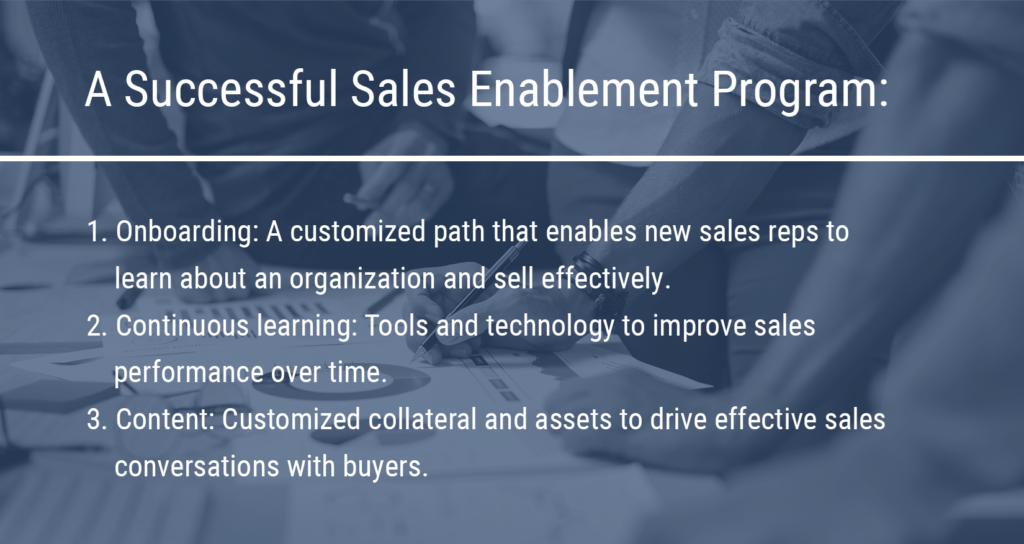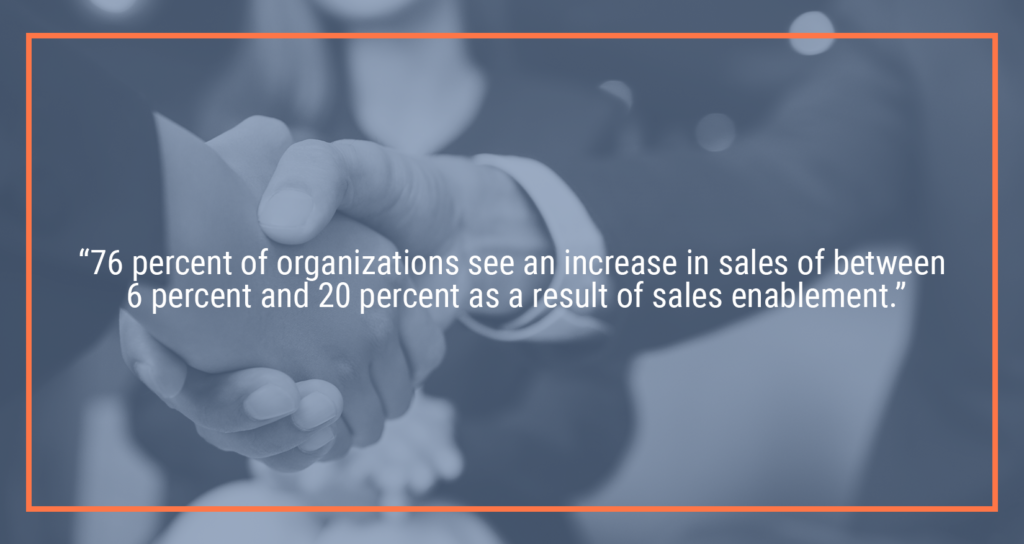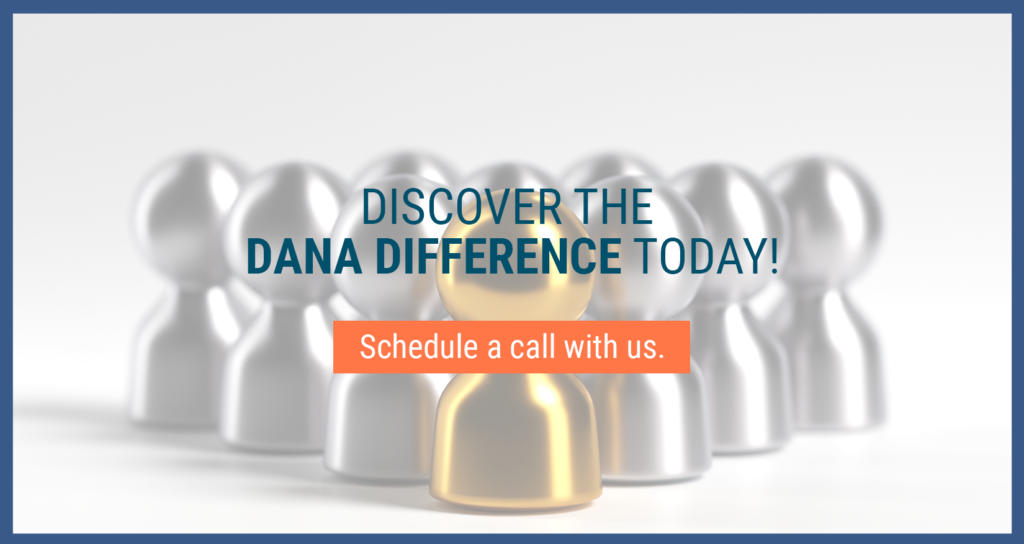
Sales enablement tools can be employed every step of the way in interactions with prospective and existing customers, from training to prospecting, lead generation, and marketing. Sales organizations have for decades invested in providing resources and content, knowledge and information, to support their sales teams in improving productivity, cutting their sales cycle, and increasing close rates. What’s new and has changed dramatically even in just the last two years is the use of technologies to make sales enablement more automated and integrated.
As machine learning and AI improve automation, today’s SaaS sales organizations increasingly oversee sales enablement programs that, rather than siloed knowledge storage systems, are more a set of interconnected solutions that use data and analytics to drive systems and processes, such as lead scoring, training and onboarding, custom messaging, and channel enablement.
In this article, we talk to experts who identify the benefits of SaaS sales enablement tools, how to choose the tools and integrate them, and how to evaluate a sales enablement program over time to better meet your sales organization’s goals.
What Is a Successful Sales Enablement Program?
Although “sales enablement” is an evolving term, and means different things to different people, based on current programs, it can be organized into roughly three categories:
- Onboarding: A customized path that enables new sales reps to learn about an organization and sell effectively.
- Continuous learning: Tools and technology to improve sales performance over time.
- Content: Customized collateral and assets to drive effective sales conversations with buyers.

Fundamentally, a successful sales enablement program supports funnel management, said Jason Ingargiola, vice president of business development at Keen Decision Systems (Durham, North Carolina), a SaaS marketing technology company that provides a predictive analytics platform to marketing executives.
A successful sales enablement program fits tools together to make pipeline management more predictable and activities more scalable and efficient. The tools empower sales teams to access the right materials, at the right time, in the right form, to move prospective clients through the funnel, and renew and maintain existing customers, reducing churn.
“Sales enablement tools help us build a more robust funnel,” Ingargiola said. At Keen Decision Systems, Ingargiola’s sales enablement program includes lead generation, two tools for prospecting, a customer relationship management (CRM) system, and marketing.
By developing a holistic system and process for using sales enablement tools in the three categories, companies can train and coach reps quicker to become more effective leaders, ultimately increasing sales and generating more revenue, said Matt Czyryca, senior manager of business transformation at Sophos (Dallas, Texas), a cybersecurity firm offering security software and hardware. Czyryca’s sales enablement program at Sophos includes CPQ (configure, price, quote) software; CRM; sales engagement; and revenue operations and business analytics solutions.
“It’s hard to argue that sales enablement doesn’t produce ROI faster,” from the training aspect alone, said Czyryca, who has been in sales for more than 15 years. Ten years ago, he said, a company had a methodology, and then perhaps once per year or per quarter, coaches came in, provided value messaging, and then the reps were told, “Go sell!”
“You were left to your own devices, and a manager might listen to a call or go to a meeting and give feedback afterward,” Czyryca said.
Fast forward to five years ago, when new hires were put through in-house sales boot camps before getting on the phone. They learned best of breed based on the habits of high-performing sales people who passed along the magic, leaning on more anecdotal information, and some data, of what they did well, he said.
Today, APIs (application programming interfaces) increasingly link tools (some manual, some automated), providing immediate, data-centric feedback on sales rep performance and customer response; and gamification ties them together to make it fun and competitive, Czyryca said. Organizations can develop an individualized platform from thousands of enablement tools to work together to meet goals and increase sales — 76 percent of organizations see an increase in sales of between 6 percent and 20 percent as a result of sales enablement.

Level the Playing Field with Sales Enablement
For a SaaS company, scalability is critical. But new hires arrive with a spectrum of skills. Sales enablement tools help newly onboarded reps or newly launched sales teams start strong for faster ramp-up and accelerated ROI.
With sales enablement tools, a turnkey playbook can be created for new reps that would normally take them six months to develop on their own, Ingargiola said. Instead, you can get them up to speed in 30 to 90 days with predictable conversations and vetted contacts.
For instance, an enablement program can empower scalability by providing new reps with a warmup list of qualifying leads or inbound leads, Ingargiola said. “While you build their skill sets, they already have a territory, which in turn allows them to learn and understand your value proposition more effectively and quicker,” he said.
Keen Decision Systems did just that when onboarding a newly launched team of sales reps, using three tools that worked together: one to develop a wealth of contact names that fit their target companies; another tool for outreach to drive awareness; and a third for marketing.
“The sooner reps are able to build a predictable pipeline, the sooner they are able to see the benefit and have success,” Ingargiola said.
Enablement tools are tailored to predictability. They offer a host of ways to go beyond a gut feeling and access advanced metrics to coach reps and increase productivity.
In an AI-driven and data-centric process:
- Conversations can be recorded and scraped for trigger words, data points can be set, and managers use reports on both in one-on-ones to describe and define best-of-breed conversations.
- Tools can track the number of days an opportunity has been in process, and then based on data, provide a grade for likelihood to close.
- Revenue intelligence tools can record and scrape emails to develop the perfect cadences.
- Automation can increase low-touch capabilities to make it easier for transactions to occur without customers talking directly to a sales person, increasing revenue with little to no contact.
These are all ways Czyryca described how an integrated platform provides powerful feedback, including from your partners and customers, and quantifies what “good” is to use in coaching sessions and to shift content — quickly.
“It’s constant enablement,” he said, which makes it less stressful for new reps. In the past, onboarding may have lasted one to two weeks. Now, enablement is ongoing. Reps live in those platforms on a daily basis, which keeps people in the processes, and sharp, over a longer period of time, Czyryca said.
Engage the Team
Organizations with a sales force fully engaged in sales enablement programs have on average 8.5 percent higher revenue attainment. The takeaway: Enablement benefits sales organizations.
Sales reps are competitive, Czyryca said. Just a few reps adopt a technology, and when their numbers keep improving, the others come from behind and use them as well.
But not everyone moves at the same pace. So data can be used to create personalized learning journeys that allow reps to self-direct, and support managers in forecasting and other decision making.
As well, to help team members stay motivated and engaged in the process, some enablement programs offer rewards. For instance, “if you move all your stage ones to stage two within a certain timeframe, you can cash in,” he said. Although the “old salty salesperson” in him hesitates at the idea of payment for selling, Czyryca said the rewards provide incentives and choice. “For people who don’t need an incentive, they can still make their money. For people who like virtual high-fives or notifications, we have that too,” he said.
Keen Decision Systems also provides a low level of compensation to engender more consistent compliance with the use of sales enablement tools. “We want the sales team to recognize that the tools are processes of success, and we want them to leverage these processes,” Ingargiola said.
Build Your Content
Once you get a team up and running, a next step is to build a content brand, Czyryca said. Win rates are about 27 percent higher at sales organizations that implement a content strategy compared with those that don’t.
With sales enablement tools, there is no guessing what sounds good and what sounds bad. Powerful scoring and tracking of content performance concretely tell the story. Significantly, organizations that adopted sales enablement tools and used those tools to align their selling processes to buyer behaviors (i.e., moving between stages of the buying process) achieved as much as 17.9 percent higher win rates and 11.8 percent higher quota attainment than those that informally or randomly adopted enablement.
Evaluate, Evolve Continuously with Sales Enablement Programs
Because new tools are continuously introduced, Czyryca is always on the lookout for new ones to improve and/or integrate with existing tools to build a better platform. “It’s a constant evaluation of products.”
Increasingly, sales enablement is its own department in charge of evaluating new tools and guiding a program. From 2013 to 2019, the percent of companies with a dedicated hire, program, or function grew by more than 40 percent to 61 percent. On LinkedIn alone there are daily more than 20,000 listings for sales enablement managers, directors, or specialists. The expectation is this job title will continue to trend higher.
“We just put someone in that role for the first time,” Ingargiola said. The new hire is tasked among other things to be apprised of new solutions; gather input and identify the challenges the company is looking to solve; conduct interviews with potential vendors; and test and report on potential differences and trade-offs. No tool is a single problem solver, and adding tools requires assessment of benefits and trade-offs, which they all have, he said.
Once the dollars are invested and the tools in place, developing a process of self-reflection on a regular schedule is necessary to assess how tools contribute to the bottom line; help to build an effective, high-quality, and predictable pipeline; and move opportunities along. With the sales enablement tools of today, the data is available to learn quicker and diagnose the quality of the pipeline and the efficiency of the sales process better.
“There is no shortage of data,” Ingargiola said. “It is how you use and deploy it.”
Adjusting, adding, or subtracting from the existing program depends on asking:
- What are your goals?
- What are you trying to improve upon?
- Is the tool helping you move through the process?
“The sales have to evolve and get better in a demonstrable way. We want it to be more predictable, more scalable, and we want the shortest time to close as possible,” Ingargiola said. “If it is, then we want to build and enhance, we invest more; if not, we look to replace the tool.”
As the pandemic wanes and travel begins again, Ingargiola said another question arises for organizations: “Do you invest in more sales enablement or travel again?” Heavy travel can be inefficient. With greater comfort with technology after working homebound for so many months, good arguments may be made that focusing on sales enablement will be the more appropriate spend, he said.
The DANA Difference
Sales enablement is a critical link between marketing and sales that supports sales representatives in increasing productivity, closing more effectively, and driving more revenue. DANA Associates is your critical link to sales candidates who you can hire with confidence. From hiring a sales enablement leader to building your SaaS sales team from the ground up, we will find you the most highly qualified candidate.
To learn more about our in-depth, personalized process, schedule an introductory call today.

